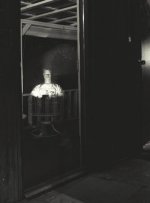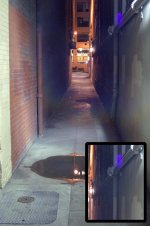I've been both interested in, and amused by, UFO pictures and the associated subculture. Being from Albuquerque, I remember, as a grade-schooler, the UFO flap in the early-mid 1960s in the southwest US. And I needn't mention the entire tourist industry built up around the so-called Roswell incident. I'm a total skeptic, of course, but I enjoy the culture of fanaticism surrounding these things; people are gullible and want to believe in something; in anything.
I've seen reprints of lots of classic UFO pictures; being rather photographically literate I seem to be able to easily identify either outright frauds (hubcaps, pie tins, etc), or dust/debris on the lens and/or film.
While in high school I made my own faked UFO pictures, using a (what else) aluminum pie tin, suspended from a broom handle with black thread, photographed at night using a Vivitar 110 flash camera. I still have several of those prints; I'll have to dig them out and post them here. The pictures appear to represent a metallic UFO flying above the treetops.
Since the advent of the digital camera being ubiquitous in our culture, there are more photographic devices being used than ever before in history. Yet we seem to see the incident rate of believable UFO pictures has dropped to virtually nothing. Not even a good hubcap-tossed-in-the-air shot anymore. Is it because the aliens are staying away? Naw! It's because the dirt, debris and other film and processing artifacts that made these accidental UFOs seem almost believable have now been replaced with point-n-shoot digital cameras with little or no such artifacts, other than out-of-focus dust and moisture on the lens. Perhaps these ghost images we see recently are the contemporary version of the old UFO pictures, generated by artifacts of the image-making process.
~Joe




